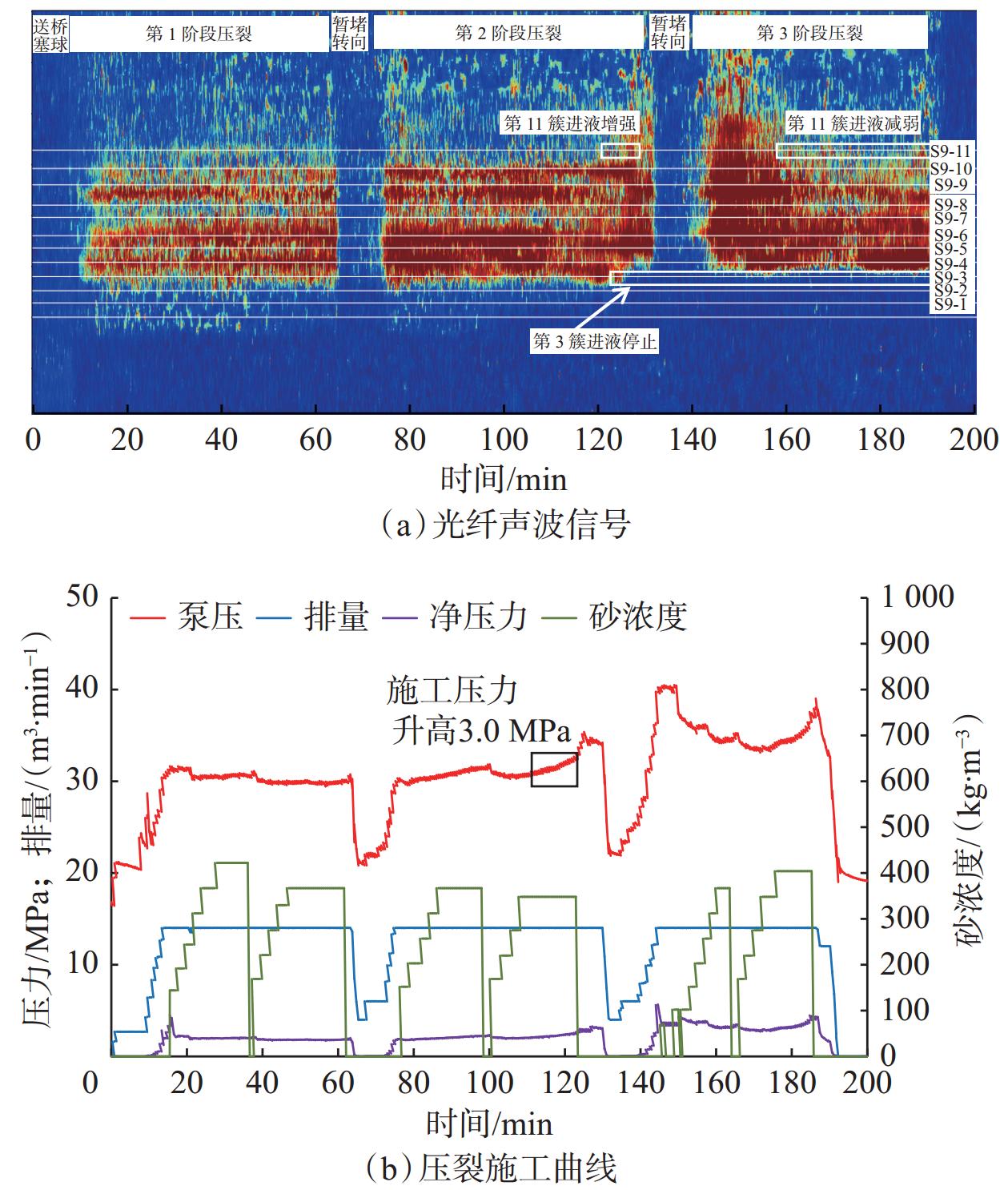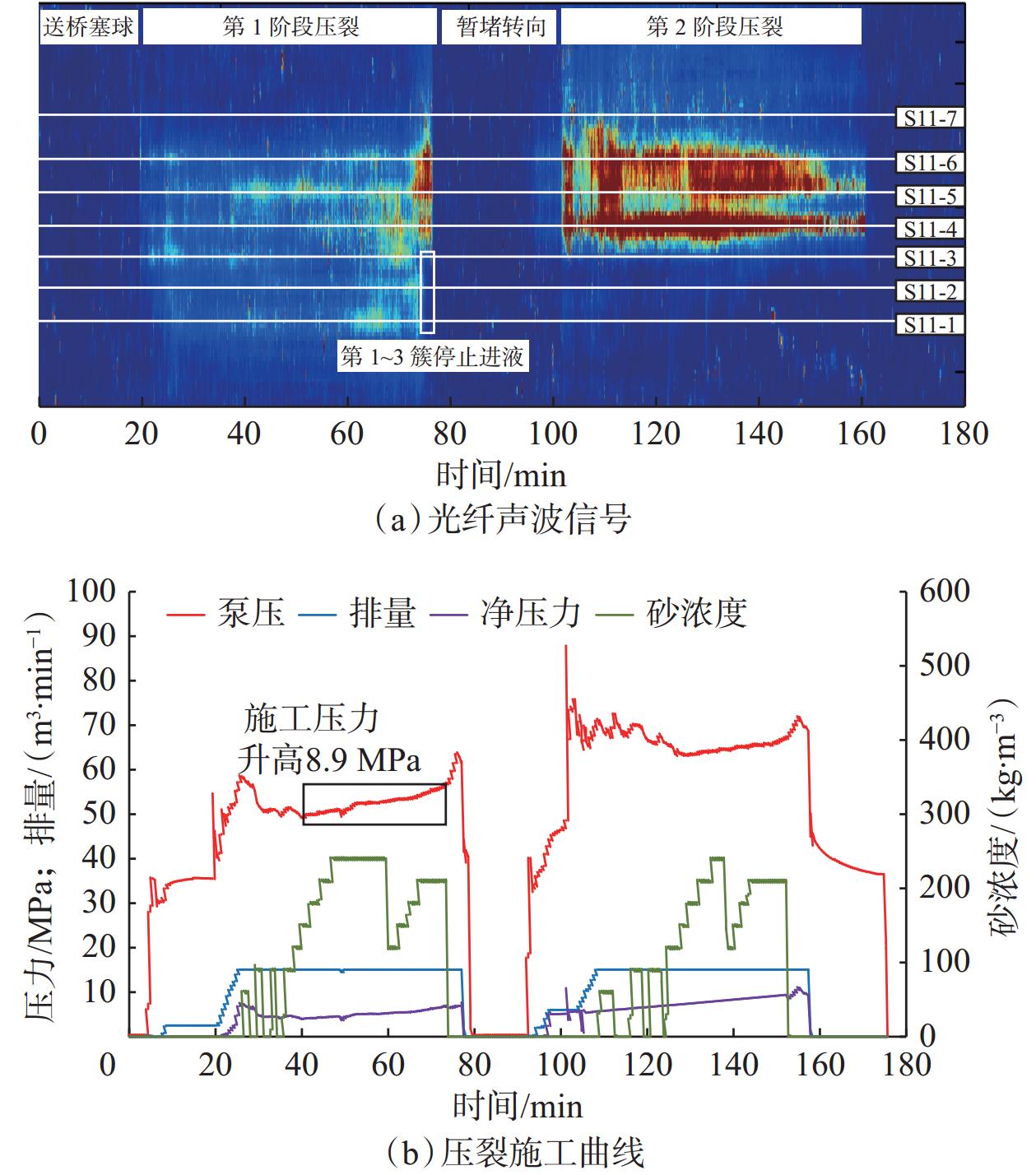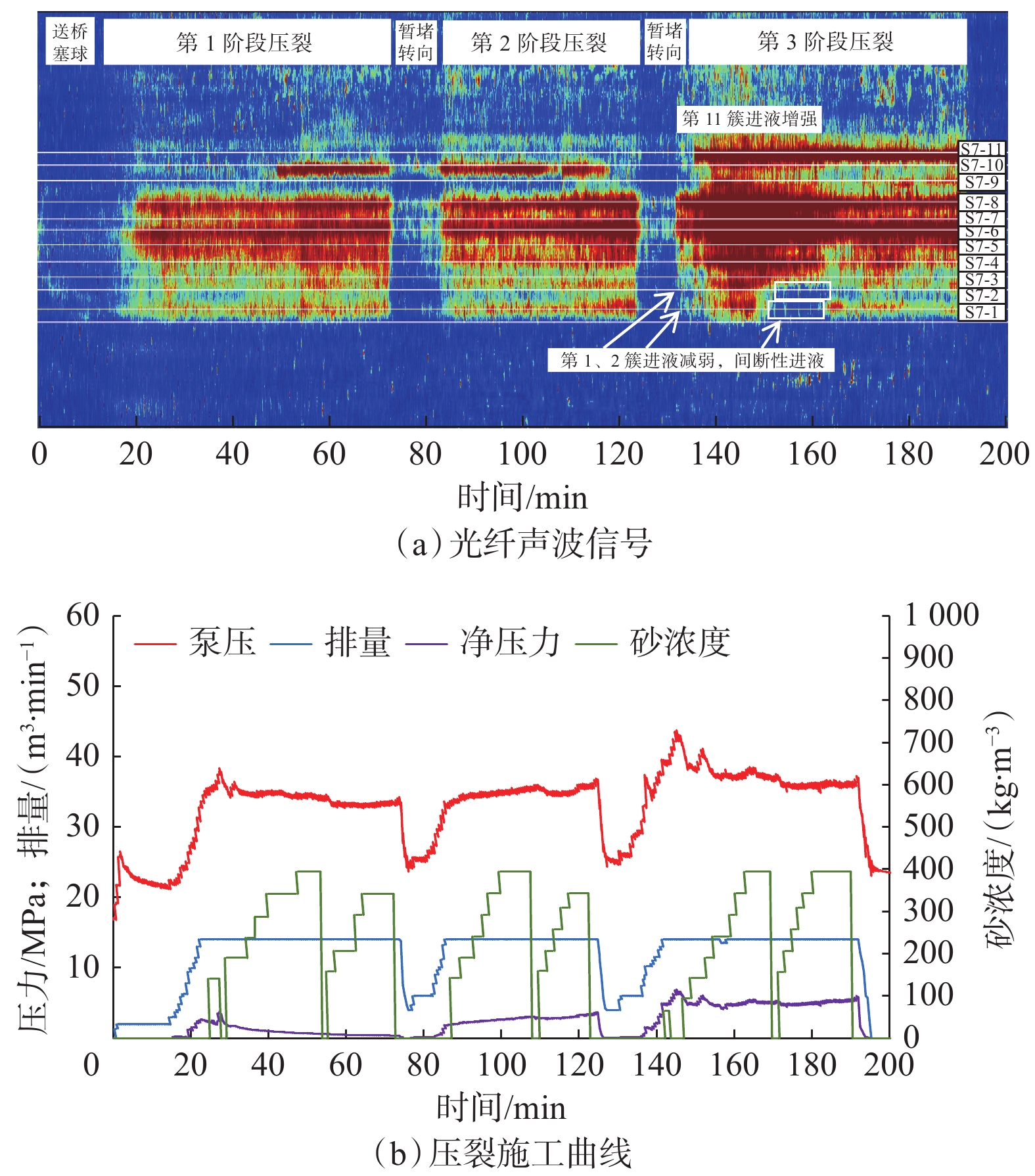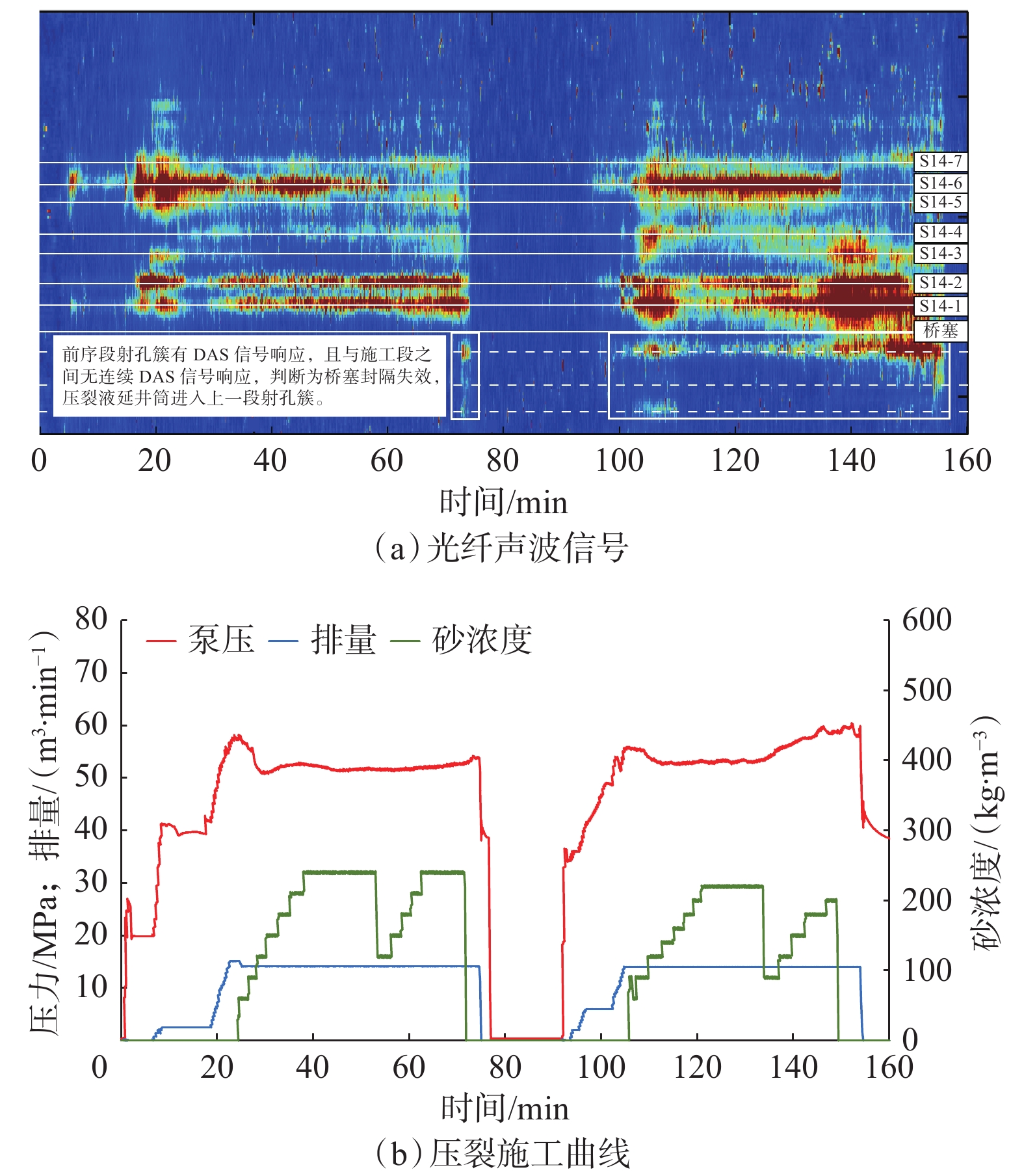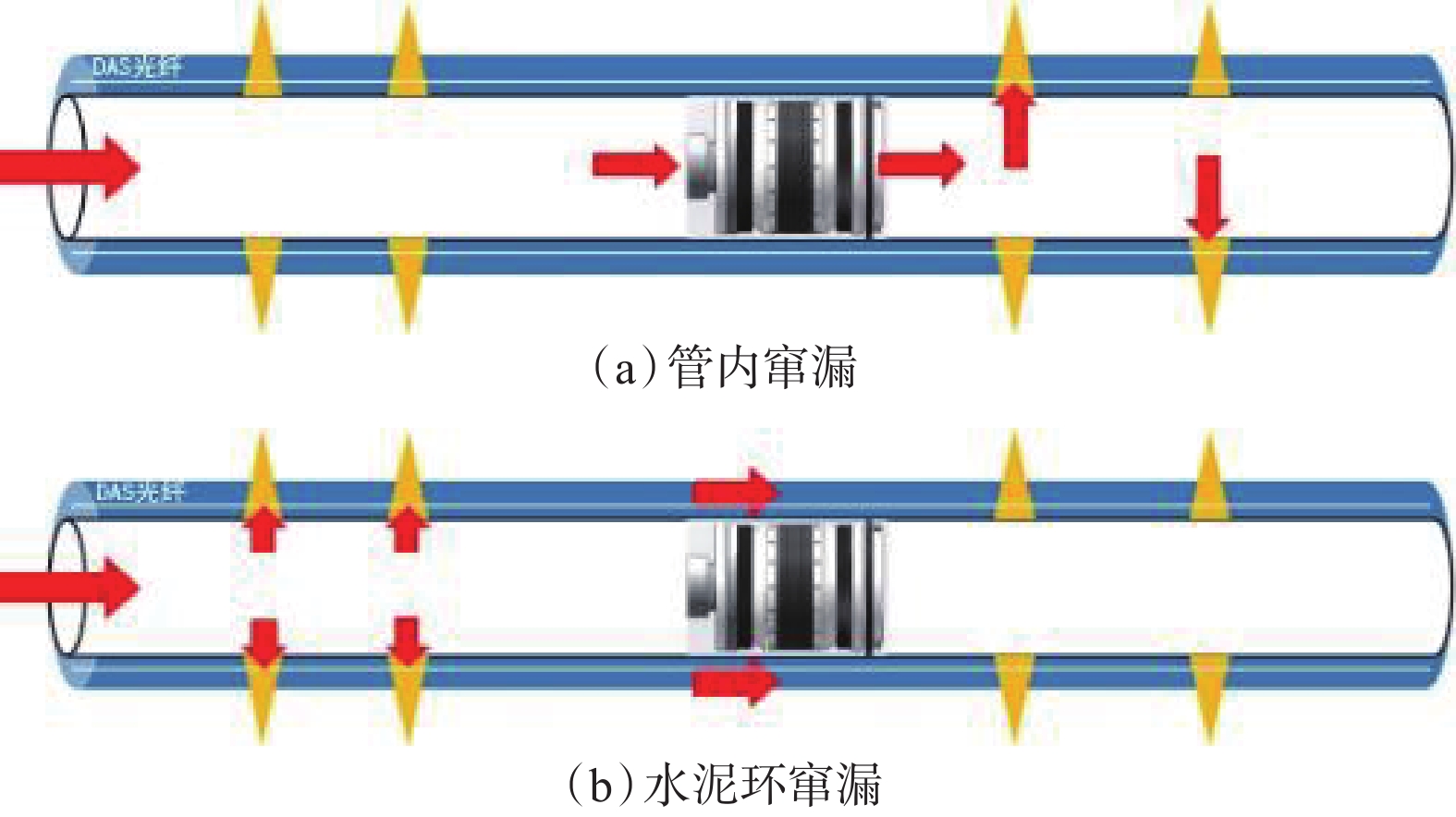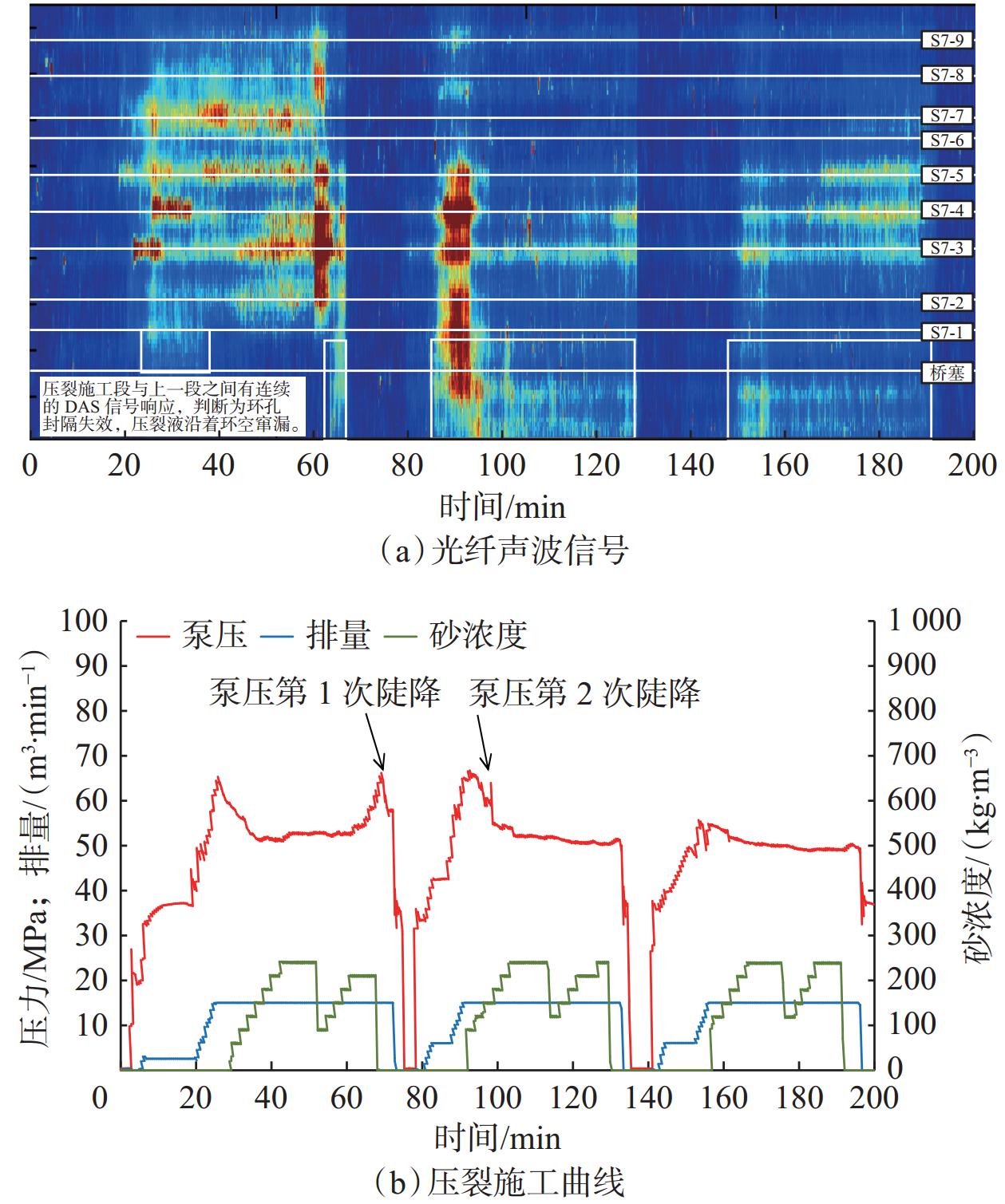Evaluation of Multi-Cluster Fracturing Effects in Horizontal Shale Gas Wells Based on Optic Fiber Monitoring Outside Casing
-
摘要:
为了分析页岩气水平井分段压裂影响多簇进液的因素,采用套管外分布式光纤开展压裂过程实时监测。以昭通页岩气示范区龙马溪组页岩水平井压裂光纤实时监测数据为基础,结合压裂设计数据和压裂施工数据,开展了分段多簇压裂过程中典型压裂事件和分布式光纤声波传感(DAS)信号的联合分析。分析结果表明:压裂初期孔眼欠完善、近井扭曲严重,容易激发强DAS信号,随着孔眼冲蚀,DAS信号减弱;多簇间流量分配呈随机动态变化,影响多簇进液的均衡性,有效进液簇数量与施工泵压具有一定相关性;暂堵、停泵−再启泵等措施能够干预簇间流量分配,暂堵效果受裂缝实时状态、暂堵参数等多因素影响;段间窜通存在2种光纤DAS信号响应模式,可揭示管内和水泥环2种段间窜漏路径。光纤监测手段和综合分析方法对于深入认识水平井分段多簇压裂机理、指导压裂方案优化和压裂实时调控具有重要的参考价值。
Abstract:In order to analyze the factors affecting multi-cluster fluid injection during multi-stage fracturing of shale gas horizontal wells, real-time monitoring of the fracturing process was carried out using distributed optic fibers outside the casing. A joint analysis of typical fracturing events and distributed optic fiber acoustic sensing (DAS) signals during multi-stage multi-cluster fracturing process was carried out based on the real-time monitoring data of optic fiber during fracturing of horizontal shale well in the Longmaxi Formation of Zhaotong Shale Gas Demonstration Zone, combined with fracturing design and operation data. The analysis finds that at the initial stage of fracturing, the perforation is not perfect, and near well distortion is serious and easy to trigger strong DAS signals. With the perforation erosion, the DAS signal weakens. There is a random dynamic change in the flow distribution between multiple clusters, which affects the uniformity of multi-cluster fluid injection. The number of effective clusters with fluid injection is correlated with operation pressure. Precautions such as temporary blocking, and pump stopping and restarting can intervene in the flow distribution between clusters, and the temporary blocking effect is influenced by multiple factors such as real-time state of fractures and temporary blocking parameters. There are two optic fiber DAS signal response modes for inter-segment leakage, which can reveal the leakage paths inside the casing and cement sheath. The optic fiber monitoring method and comprehensive analysis method have important reference values for an in-depth understanding of the mechanism of multi-stage multi-cluster fracturing of horizontal wells, guiding fracturing scheme optimization and real-time fracturing adjustment.
-
低渗透稠油油藏储量丰富,是重要的非常规油气资源,是我国原油增储上产的主力军,但较低的渗透率及地下原油的高黏度,使得开发过程中原油流动低、动用性差,导致低渗透稠油油藏采收率普遍较低[1]。开发时存在油藏渗透率低、注入压力大、水油流度比大和水驱效果差等主要问题,采用热采开发时注入热水的加热半径小,注降黏剂的降黏区间小,原油泄油半径小、供液能力差[2]。对于黏土含量高的储层,热采降黏开发方式效果差,亟需结合其他提高采收率(enhanced oil recovery,EOR)技术进行采油[3–8]。
CO2驱具有膨胀原油、降低原油黏度、降低界面张力和提高原油流动性等优势,已在低渗透、致密油藏中进行了应用并取得了良好效果,目前逐渐应用于稠油开发中[9–15]。孙而杰等人[16]利用物理模拟试验对比了稠油油藏中不同CO2注入方式下的驱油效率,结果说明水气交替注入时CO2驱油效率比水驱提高10%~15%。孙焕泉等人[17]采用正交试验分析了各影响因素对稠油油藏注CO2提高采收率能力的影响规律,结果发现温度对提采影响最大,其次为渗透率、压力、原油类型。王俊衡等人[18]开展了可视化CO2辅助蒸汽驱油试验,分析了CO2与蒸汽驱的协同作用及注入方式对驱油效果的影响。P. V. Parracello等人[19]通过开展CO2膨胀试验研究了CO2与原油间的相互作用,结果表明CO2可使原油膨胀并降低原油黏度,从而增大原油流度。Zheng Sixu等人[20]利用室内试验和数值模拟方法开展了不同井型下注CO2对稠油油藏的增能效果和提高采收率能力研究,分析了初始含油饱和度、采油速率、含水率、气油比、最终采收率和剩余油饱和度分布情况,发现对于薄层稠油油藏,水平井注CO2提采效果更好。S. M. Seyyedsar等人[21]提出采用循环间歇的方式向稠油油藏中注入CO2,结果证明该方法特别适合重质组分稠油油藏,因为它增强了注入CO2与稠油之间的接触,提高了稠油的开采潜力。S. M. Seyyedsar等人[22]通过室内试验研究了CO2对稠油提采的主要作用机理,结果表明CO2溶解使原油黏度降低、原油的膨胀及CO2对原油的萃取作用可显著提高原油采收率,水驱后注CO2采收率能提高23%。Huang Tuo等人[23]通过岩心驱替试验,测试了不同的驱替方式,并通过数值模拟拟合试验数据,分析了不同CO2驱替方式的驱油机理。S. A. Farzaneh等人[24]在阿拉斯加北坡的稠油油藏条件下进行了驱替试验,模拟了不同的注入方式,包括水驱、CO2驱以及水和CO2联合注入,并对比了不同注入方式的驱替效果,结果表明:稠油中CO2的溶解和油黏度的显著降低,使得CO2注入期间原油采收率变大;将CO2和水同时注入比单独注入水或CO2更能提高采收率;CO2交替注入方式最终原油采收率为74%,比水驱高出30%。
CO2和原油作用后可显著改善稠油性质,但常规CO2驱地层能量补充效率低。为此,胜利油田首次提出采用压驱注入模式进行CO2驱油。目前,科研人员针对压驱注水进行了一定的研究,矿场试验表明,压驱效果优于传统的水力压裂技术[25–27]。同时,部分学者采用数值模拟及物理模拟试验对压驱过程中的裂缝扩展情况进行了研究,并分析了压驱过程中的提高采收率机理[28–32],但现有研究主要针对压驱注水开发,对稠油油藏CO2压驱开采方面的研究较少。CO2压驱是指使用类似压裂的大流量注入(CO2),同时实现储层压裂改造和CO2驱油的双重作用,使注入井附近产生裂缝,增强CO2的注入能力,增大CO2的波及范围及注入深度,但对CO2压驱的开采机理,压驱过程中的压力场、渗流场及流体饱和度场变化及所适合的注采参数尚不明确。因此,笔者首先构建了稠油与CO2的相态模拟,分析了CO2对稠油的相关作用机理;然后,基于有限元离散法,建立了裂缝扩展渗流场−应力场耦合模型,分析了注入压力对裂缝扩展行为的影响;最后,基于裂缝生成模拟结果,建立了考虑CO2复合压驱后形成复杂裂缝的数值模型,研究了CO2压驱过程中的裂缝扩展行为,并对CO2压驱工艺参数进行了优化,为稠油油藏CO2压驱开发提供了理论依据。
1. CO2对稠油的作用机理
采用Winprop相态模拟技术研究CO2对稠油性质的影响,通过对PVT试验数据进行拟合来调整状态方程(EOS)参数,以建立符合真实流体的相态模型。拟合流程主要包括:将原油特性参数导入相态拟合处理软件中,模拟注气膨胀试验等过程中的相态变化;将PVT试验数据作为回归变量输入相态软件中,通过调整部分原油组分的偏心因子、临界压力、临界温度、二元交互作用系数、体积偏移系数等对回归变量进行拟合,通过不断调整状态方程参数,最终使模拟预测值与试验值之差在规定误差范围内。
1.1 原油组分
原油取自垦119区块沙三下段地层。根据组分的摩尔分数计算,该原油含有0.076% CO2、0.228% N2、25.582% C1、2.867% C2、0.951% C3、0.342% C4、0.081% C5、0.030% C6、0.010% C7、0.005% C8、0.615% C9、0.555% C10、0.675% C11、67.983% C12+。原油密度为1.064 6 kg/L,地层温度下黏度为4 939 mPa∙s,含水率为18.5%。按照生产气油比15 m3/m3对原油复配后测量地层温度下原油黏度,为1 099 mPa∙s。该区块储层压力为22 MPa,温度为99 ℃。
在不影响计算精度的情况下对原油流体的物性参数进行拟合,将原油流体的16个组分合并为6个拟组分,以降低组分模型的复杂性,提高数值模拟的计算效率。使用目前的流体模型对地层流体特性进行拟合,主要包括原油饱和压力、原油密度及黏度等。拟合结果表明,整体拟合情况较好,部分数据点拟合稍有偏差,但总体误差在2%之内(见表1)。因此,拟合结果可以反映地层原油的组分特征,能够满足后续数值模拟计算的精度要求。
表 1 参数拟合结果Table 1. Parameter fitting results拟合参数 饱和压力/
MPa地面脱气油密度/
(kg·L−1)地层油黏度/
(mPa·s)试验值 4.30 0.962 8 1 099 拟合值 4.23 0.946 7 1 099 误差,% 1.63 1.70 0 1.2 CO2−原油作用机理
注入CO2后,对原油的物性参数及相行为均有很大影响。油藏条件下,CO2处于超临界状态,易溶于原油,降低原油黏度,增大饱和压力。
1.2.1 CO2对稠油的降黏作用
CO2注入量对地层原油黏度的影响如图1所示。地层温度压力条件下地层原油黏度为1 100 mPa·s,当注入的CO2的摩尔分数分别为5%,10%,15%,20%,25%和35%时,原油黏度分别下降为890,770,680,610,580和500 mPa·s。当向原油中注入摩尔分数为25%的CO2时,原油黏度下降了50%,说明CO2溶解后能显著提高原油流动性。这是因为,随着CO2注入量增加,稠油中溶解CO2后,CO2进入稠油分子中,起到溶胀作用(具体见1.2.2节),增大了分子间距,从而使体系分子间的相互作用力减弱。除此之外,稠油中通常含有胶质沥青质,CO2的溶解对重质组分的破坏可以改变原油性质。因此,通过以上2种作用,随着不断注入CO2,原油黏度不断降低。
1.2.2 CO2对稠油饱和压力及原油膨胀系数的影响
注入CO2对地层原油饱和压力的影响如图2所示,对膨胀系数的影响如图3所示(膨胀系数为注气后原油饱和体积与初始原油饱和体积的比值)。
从图2、图3可以看出,注入CO2后,原油−CO2体系的饱和压力增大;注入CO2的摩尔分数分别为5%,10%,15%,20%,25%和35%时,原油−CO2体系的饱和压力由原来的4.3 MPa分别增大至4.8,5.4,5.9,6.5,7.07和10.2 MPa,原油的膨胀系数分别为1.01,1.03,1.05,1.07,1.09和1.14。研究结果表明,随着CO2注入量增大,饱和压力不断增大,说明CO2在稠油中有一定的溶解能力;随着CO2注入量增大,原油的膨胀系数不断增大,这主要是因为CO2溶解后导致了溶胀作用。模拟计算结果与试验结果较为吻合,说明拟组分及所选取的相态参数可以准确反映该区块流体性质,可以用于后续数值模拟计算。
2. CO2压驱裂缝开启模拟
以垦119-10砂体中K119-10井的地质模型为基础,建立了压驱过程流固耦合的数值模型(地质力学概念模型),如图4所示。其中,模型i和j方向网格数50个,网格采用非均匀间隔、局部精细的设置方式,以准确模拟裂缝开启的瞬态效应。网格步长设置为20 m×10、10 m×5、4 m×5、1 m×11、4 m×5、10 m×5、20 m×10;纵向上划分为5层,网格总数26 010个。流体参数、岩石物理参数等均采用K119-10井实际参数,采用一注四采模型。模型油藏压力为21.96 MPa,油藏温度为99 ℃,油藏顶部深度为2 105 m;原油饱和压力为4.23 MPa,地面脱气油密度为0.946 7 kg/L,地层油黏度为1 099 mPa·s,其相渗曲线如图5所示。
基于有限元的离散人工裂缝模拟思路,通过CMG软件中地质力学网格GEOGRID方法,实现了压驱过程人工裂缝的开启模拟。在进行地质力学模拟时,模型中会加入另外一套地质力学网格,设置软件时遵循以下原则:1)油藏主网格必须包含至少2个地质力学网格生成的裂缝沿着它们共同的边缘,以便使裂缝可以穿过油藏主网格中心;2)裂缝宽度相比于裂缝长度非常小,当裂缝出现时,虽然地质力学网格分开但油藏主网格始终保持连续,即油藏主网格不会发生形变,而地质力学网格则会发生形变。使用弹性模量、泊松比、内摩擦角和内聚力作为应力的函数来定义地层的地质力学性质,以说明压力变化导致的材料强度变化。弹性模量、泊松比用来描述储层的弹性变形行为,摩尔−库仑准则定义储层塑性行为开始时的应力状态。随着流体大量注入,多孔介质内孔隙流体压力发生变化,引起储层有效应力改变及其重新分布,最终导致油藏多孔介质变形。多孔介质变形过程中采用有限元离散法模拟裂缝的开启。同时,多孔介质的变形又将导致储层孔隙体积的改变,进而影响流体的流动与注入。该渗流场−应力场的耦合作用过程如图6所示。
基于上述渗流场−应力场耦合过程,得到压驱过程中的裂缝变化,如图7所示。
模拟裂缝开启长度随压驱压力的增大逐渐增长,当压力从初始地层压力增大至50 MPa时,裂缝开启速度快,主裂缝长度从0增大至150 m;当压力继续增大至70 MPa时,裂缝开启长度增速变缓,从150 m继续增大至170 m。模拟结果表明,合理的CO2压驱注入压力为40~50 MPa。
基于CMG地质力学模型确定的注入流体参数,利用非常规裂缝模拟方法(UFM)使用非结构化网格模拟裂缝扩展,该方法能够考虑天然裂缝及应力阴影对压裂段的影响,准确模拟裂缝的三维扩展路径。本模拟方案采用三级泵注程序,进行了K119-10井压裂模拟,生成了SRV体积压裂网格(如图8所示),直观展现出压裂改造范围。
由压驱过程中的压力场传播情况可知,高速注入CO2可以快速增加地层能量,且压力沿裂缝方向传播速度最快,在裂缝波及区域可以有效补充地层能量,随着注入量增加,压力波及范围以裂缝为中心不断向外扩展。
由于目前并没有可以进行油田区块尺度上全耦合流场−力学场的成熟模拟器,如上所述,本次研究采用多个软件建立了一种分步耦合的方法,使其在考虑压驱过程中流固耦合裂缝开启条件的同时又能在区块尺度上进行快速模拟,结果如图9所示。
首先,基于Winprop建立真实流体模型,为地质力学模型提供储层流体参数。地质力学模型基于真实地质情况建立,具有实际储层特征,同时考虑了储层的地质力学特征,但其局限性在于启裂裂缝只能在网格方向上生成,裂缝形态被忽略。因此,采用Petrel模型进行裂缝形态和展布范围研究,但模型中未导入实际储层流体物性参数。然后,考虑CO2流体相互作用机制下的开发技术,在CMG模型中开展,通过网格加密建立裂缝形态等效模型,同时具有实际储层的流体、地质特征。
3. CO2压驱驱油规律研究
基于裂缝生成模拟结果,建立了考虑CO2复合压驱形成复杂裂缝的数值模型。近井带微裂缝参考泵注程序模拟结果采用增大生产指数方法,主裂缝采用基于CMG流固耦合技术的裂缝模拟结果。采用上述模型和方法,对K119-10井进行了压后生产模拟。
3.1 不同注入压力地层起压规律
利用建立的数值模型进行注CO2压驱模拟,控制井口的注入压力分别为20,30,40,50和60 MPa,注CO2压驱生产6个月后,地层压力分布情况及不同生产时间下的地层平均压力变化情况如图10所示。
从图10(a)可以看出,随着压力升高,CO2在原油中的扩散溶解能力增强,更容易扩散至远井带,导致远井带压力上升。从图10(b)可以看出,随着CO2波及范围扩大,压力传递范围增大,因而注CO2能够有效提升整个地层的平均压力。提高注入压力,能够更快地提升地层压力,但当注入压力高于50 MPa时,可以看出,对地层压力的提升变得不再显著。
3.2 稠油CO2压驱中的CO2运移规律
采用定流量(注入量为2 000 m3/d)注入CO2,对CO2压驱过程中的运移规律进行了分析。注CO2压驱不同时间后的CO2储量丰度分布如图11所示,平面上CO2主要在近井带聚集,从近井带到远井带丰度逐渐降低。随着时间推移,CO2前缘不断向外扩展增大,注气3,6,12,15,18和21个月时,对应的CO2波及距离分别为50,70,90,100,110和120 m,前12个月波及速度快,12个月之后由于波及面积逐渐增大,运移速度减缓。
为了研究CO2在储层纵向上不同小层的分布关系,分别对均质储层和非均质储层中CO2的丰度分布进行了模拟研究,模拟结果如图12所示。进行模拟时,2类模型均设置为4小层,均质储层各小层的渗透率均为500 mD,而非均质储层是根据实际储层各小层的储层物性进行设计,4小层从上到下分别为645,369,75和76 mD。研究可知,对于均质储层,各小层的波及范围没有差距,但由于气体超覆作用,上部储层CO2更容易聚集,导致上部层位的CO2丰度显著增高;对于实际区块,由于上部层位渗透率高,注入的CO2主要聚集在上部层位,在气体超覆作用下第一小层的CO2波及范围及聚集丰度显著高于其他小层。由此分析可得,储层的非均质性对CO2在储层纵向上的运移具有显著影响。
3.3 稠油CO2压驱黏度场变化特征
对压驱过程中原油的黏度场进行了分析,结果如图13所示。压驱过程中,伴随CO2在地层中的扩散溶解作用,近井带被CO2波及地层的原油黏度明显降低,CO2前缘由于CO2丰度降低,原油黏度升高;由于前期水驱对原油的压缩作用,以及注入端的压力增高,导致CO2前缘以外地层高压力区的原油黏度有所升高;随着时间推移,CO2不断扩散,CO2的波及面积逐渐扩大,使得地层低黏度场范围逐渐扩大。不同注气阶段的地层黏度场分布特征如图13(a)所示,CO2压驱6个月后实际储层纵向不同层位间黏度场的分布特征如图13(b)所示。从图13(b)可以看出,不同层位间的原油黏度分布差异比较大,顶部储层渗透率高,CO2扩散快,能够有效降低原油黏度,低黏度场分布范围大;相反地,低渗透的底部地层,低黏度范围较小。同时,由于离注入井较近的地带地层压力高,对原油有压缩作用,形成了高黏度带;后期随着CO2注入,高黏度带向外扩展,底层高黏度带更明显。
3.4 CO2压驱驱油应用前景
稠油油藏的高效开发充满复杂性与挑战性,特别是有效降黏与储层条件的深度改善,是亟待解决的关键技术瓶颈[33]。长期以来,热采法作为稠油开采的主导方式,虽然在一定程度上提高了采收率[34],但其固有的高能耗、高排放问题,不仅加剧了能源危机,也与全球生态文明建设的宏伟目标背道而驰。
“压—注—采”一体化压驱技术,初始基于水驱致密储层“注不进、采不出”的难题而被提出,经过20余年的持续攻关与技术发展,在补充地层能量、增大波及体积、提高缝控程度方面取得突破性成果[35]。CO2压驱技术巧妙地将CO2的物理化学特性与压驱技术的增能增渗优势结合,为稠油油藏的开发提供了新的解决方案:一方面,CO2作为溶剂,能够有效渗透至稠油分子间,通过溶解、膨胀等机制显著降低原油黏度,从而提高其流动性;另一方面,压驱过程中的高压作用不仅补充了地层能量,还通过改善储层孔隙结构、增加渗透率,为原油的顺利采出创造了有利条件。
在深入探索与验证下,“压—注—采”一体化压驱技术展现了解决稠油开采难题的卓越成效,为稠油油藏的高效开发开辟了新的道路。从技术层面来看,CO2压驱技术凭借其独特的降黏与增能增渗机制,为稠油油藏的高效、绿色开发提供了强有力的技术支持。随着研究的不断深入与技术的持续优化,该技术在提高采收率、降低开采成本和减少环境污染等方面将展现出更加显著的优势。未来,科研人员可以进一步探索CO2与稠油之间的相互作用机理,优化压驱工艺参数,以期实现更加精准、高效的开发效果。从应用层面来看,CO2压驱技术具有广泛的适应性,可应用于多种类型的稠油油藏。随着全球对绿色低碳能源需求的日益增长,该技术的环保特性与经济效益将更加凸显。在油田开发实践中,有望与现有热采法形成互补,共同推动稠油油藏开发的多元化与可持续发展。此外,CO2压驱技术还具备与其他先进技术相结合的潜力。例如,与微纳米技术、智能井控技术等相结合,可以进一步提升稠油油藏开发效率与智能化水平;与碳捕捉与封存(CCS)技术相结合,可以实现CO2的循环利用与永久储存,从而推动能源产业与环境保护的双赢发展。
4. 结 论
1)储层注入CO2可以有效改善原油性质,降低原油黏度,增大原油膨胀系数。当向原油中注入摩尔分数为25%的CO2时,原油黏度下降50%,验证了CO2在降低原油黏度方面的显著效果;原油的膨胀系数也随之增大,表明CO2的注入不仅改善了原油的流动性,还增强了其开采潜力。
2)基于离散法的压驱裂缝开启模拟结果揭示了裂缝开启的复杂规律。其中,从压驱裂缝开启角度考虑,建议合理的压驱注入压力为40~50 MPa。此外,建立了考虑CO2压驱形成复杂裂缝的数值模型,为研究CO2压驱驱油规律提供了有力的工具。
3)系统分析了注入压力对地层起压规律、驱替前缘运移规律以及黏度渗流场变化规律的影响,明确了压驱过程中CO2溶解降黏、增能助排、扩大波及范围等开采机理对低渗稠油开发的作用机理。
4)CO2压驱技术短期内对原油性质及开采效率有显著提升,但仍需深入评估长期运行下的效果稳定性、地层结构变化及CO2封存安全性等问题。实际压驱过程中,地层中多相流体(油、气、水和CO2等)存在复杂的耦合作用,需要进一步研究上述作用对压驱效果、裂缝扩展及原油流动特性的影响。
-
表 1 试验井典型压裂段的设计参数
Table 1 Design parameters of typical fracturing section of test well
井号 段序 段长/m 簇数量 簇间距/m 总孔数 施工排量/(m3·min−1) 平均单孔进液量/(m3·min−1) YS-A 7 94.00 11 6.00~9.00 44 14 0.32 9 96.00 11 6.00~9.00 44 14 0.32 YS-B 7 80.00 9 6.50~8.50 36 15 0.42 11 61.00 7 6.50~8.50 35 14 0.40 12 64.00 6 6.50~10.50 36 14~16 0.42 14 59.00 7 6.50~8.50 35 14 0.40 -
[1] 梁兴,王松,刘成,等. 光纤传感技术在昭通山地页岩气勘探开发实践中的应用进展[J]. 石油物探,2022,61(1):32–40. LIANG Xing, WANG Song, LIU Cheng, et al. Progress of the application of optical fiber sensing technology in shale gas exploration and development practice in the Zhaotong mountain area[J]. Geophysical Prospecting for Petroleum, 2022, 61(1): 32–40.
[2] 李海涛,罗红文,向雨行,等. DTS/DAS技术在水平井压裂监测中的应用现状与展望[J]. 新疆石油天然气,2021,17(4):62–73. LI Haitao, LUO Hongwen, XIANG Yuxing, et al. The application status and prospect of DTS/DAS in fracturing monitoring of horizontal wells[J]. Xinjiang Oil & Gas, 2021, 17(4): 62–73.
[3] HOLLEY E H, KALIA N. Fiber-optic monitoring: stimulation results from unconventional reservoirs[R]. URTEC 2151906, 2015.
[4] HOLLEY E H, MOLENAAR M M, FIDAN E, et al. Interpreting uncemented multistage hydraulic-fracturing completion effectiveness by use of fiber-optic DTS injection data[J]. SPE Drilling & Completion, 2013, 28(3): 243–253.
[5] SOOKPRASONG P A, HURT R S, GILL C C, et al. Fiber optic DAS and DTS in multicluster, multistage horizontal well fracturing: interpreting hydraulic fracture initiation and propagation through diagnostics[R]. SPE 170723, 2014.
[6] SOMANCHI K, O'BRIEN C, HUCKABEE P, et al. Insights and observations into limited entry perforation dynamics from fiber-optic diagnostics[R]. URTEC 2458389, 2016.
[7] JACOBS T. Hess research project points to fewer wells and passive producers that “harvest” offset fractures[J]. Journal of Petroleum Technology, 2022, 74(4): 32–39.
[8] 吴宝成,王佳,张景臣,等. 管外光纤监测压裂单簇裂缝延伸强度现场试验[J]. 钻采工艺,2022,45(2):84–88. WU Baocheng, WANG Jia, ZHANG Jingchen, et al. Field test of single cluster fracture extension strength monitoring by optical fiber outside casing[J]. Drilling & Production Technology, 2022, 45(2): 84–88.
[9] 吕振虎,吕蓓,罗垚,等. 基于光纤监测的段内多簇暂堵方案优化[J]. 石油钻探技术,2024,52(1):114–121. LYU Zhenhu, LYU Bei, LUO Yao, et al. Optimization of in-stage multi-cluster temporary plugging scheme based on optical fiber monitoring[J]. Petroleum Drilling Techniques, 2024, 52(1): 114–121.
[10] 桑宇,隋微波,曾波,等. 深层天然裂缝性页岩储层水力压裂光纤监测远场应变分析[J]. 天然气工业,2024,44(5):56–67. SANG Yu, SUI Weibo, ZENG Bo, et al. Far-field strain analysis for fiber optic monitoring of hydraulic fracturing in a deep naturally fractured shale reservoir[J]. Natural Gas Industry, 2024, 44(5): 56–67.
[11] 郭建春,赵峰,詹立,等. 四川盆地页岩气储层暂堵转向压裂技术进展及发展建议[J]. 石油钻探技术,2023,51(4):170–183. GUO Jianchun, ZHAO Feng, ZHAN Li, et al. Recent advances and development suggestions of temporary plugging and diverting fracturing technology for shale gas reservoirs in the Sichuan Basin[J]. Petroleum Drilling Techniques, 2023, 51(4): 170–183.
[12] 邹龙庆,何怀银,杨亚东,等. 页岩气水平井暂堵球运移特性数值模拟研究[J]. 石油钻探技术,2023,51(5):156–166. ZOU Longqing, HE Huaiyin, YANG Yadong, et al. Numerical simulation study on the migration characteristics of ball sealers in horizontal shale gas wells[J]. Petroleum Drilling Techniques, 2023, 51(5): 156–166.
[13] 蒋廷学,王海涛,赵金洲,等. 深层页岩气水平井多级双暂堵压裂关键工艺优化[J]. 天然气工业,2023,43(11):100–108. JIANG Tingxue, WANG Haitao, ZHAO Jinzhou, et al. Optimized multi-stage dual temporary plugging fracturing technology in deep shale gas horizontal wells[J]. Natural Gas Industry, 2023, 43(11): 100–108.
[14] 盛茂,张家麟,张彦军,等. 基于数据驱动的水平井暂堵压裂有效性评价新模型[J]. 天然气工业,2023,43(9):132–140. SHENG Mao, ZHANG Jialin, ZHANG Yanjun, et al. A new data-driven effectiveness evaluation model of temporary plugging fracturing for horizontal wells[J]. Natural Gas Industry, 2023, 43(9): 132–140.
[15] 胡东风,任岚,李真祥,等. 深层超深层页岩气水平井缝口暂堵压裂的裂缝调控模拟[J]. 天然气工业,2022,42(2):50–58. HU Dongfeng, REN Lan, LI Zhenxiang, et al. Simulation of fracture control during fracture-opening temporary plugging fracturing of deep/ultra deep shale-gas horizontal wells[J]. Natural Gas Industry, 2022, 42(2): 50–58.
[16] 蔡海文,叶青,王照勇,等. 基于相干瑞利散射的分布式光纤声波传感技术[J]. 激光与光电子学进展,2020,57(5):050001. CAI Haiwen, YE Qing, WANG Zhaoyong, et al. Distributed optical fiber acoustic sensing technology based on coherent Rayleigh scattering[J]. Laser & Optoelectronics Progress, 2020, 57(5): 050001.
[17] 隋微波,温长云,孙文常,等. 水力压裂分布式光纤传感联合监测技术研究进展[J]. 天然气工业,2023,43(2):87–103. SUI Weibo, WEN Changyun, SUN Wenchang, et al. Joint application of distributed optical fiber sensing technologies for hydraulic fracturing monitoring[J]. Natural Gas Industry, 2023, 43(2): 87–103.
[18] SOOKPRASONG P A, HURT R S, GILL C C. Downhole monitoring of multicluster, multistage horizontal well fracturing with fiber optic distributed acoustic sensing (DAS) and distributed temperature sensing (DTS)[R]. IPTC 17972, 2014.
[19] PAKHOTINA I, SAKAIDA S, ZHU Ding, et al. Diagnosing multistage fracture treatments with distributed fiber-optic sensors[J]. SPE Production & Operations, 2020, 35(4): 852–864.
[20] 周彤,张士诚,陈铭,等. 水平井多簇压裂裂缝的竞争扩展与控制[J]. 中国科学(技术科学),2019,49(4):469–478. ZHOU Tong, ZHANG Shicheng, CHEN Ming, et al. Competitive propagation of multi-fractures and their control on multi-clustered fracturing of horizontal wells[J]. SCIENTIA SINICA Technologica, 2019, 49(4): 469–478.
[21] 李勇明,陈曦宇,赵金洲,等. 射孔孔眼磨蚀对分段压裂裂缝扩展的影响[J]. 天然气工业,2017,37(7):52–59. LI Yongming, CHEN Xiyu, ZHAO Jinzhou, et al. Influence of perforation erosion on multiple growing hydraulic fractures in multistage fracturing[J]. Natural Gas Industry, 2017, 37(7): 52–59.
[22] SNIDER P, BAUMGARTNER S, MAYERHOFER M, et al. Execution and learnings from the first two surface tests replicating unconventional fracturing and proppant transport[R]. SPE 209141, 2022.
[23] MONDAL S, GARUSINGHE A, ZIMAN S, et al. Efficiency and effectiveness-a fine balance: an integrated system to improve decisions in real-time hydraulic fracturing operations[R]. SPE 209127, 2022.
[24] RIBEIRO L, ZUROVEC W. Practical design considerations for perforation and stimulation strategy based on two permanent fiber optics tests in the Williston Basin[R]. SPE 209183, 2022.
-
期刊类型引用(1)
1. 汤勇,程民茂,秦佳正,袁晨刚,洪迎河. 低渗砂砾岩油藏注CO_2+化学剂驱油机理. 华南师范大学学报(自然科学版). 2025(01): 51-59 .  百度学术
百度学术
其他类型引用(0)



 下载:
下载:
















